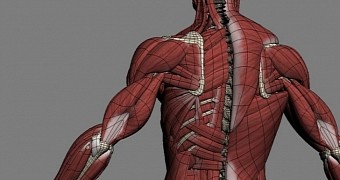A paper published in yesterday's issue of the journal Nature Medicine details a novel way to make muscles grow. Oddly enough, the paper does not even mention scary-looking exercise equipment or workout routines.
It does, however, reference muscle stem cells, proteins, protein inhibitors, and all sorts of other sciency terms and monikers. In a nutshell, this paper details how to toy with the body's inner working to promote muscle mass growth.
Skeletal-muscle health explained
Writing in the journal Nature Medicine, scientists with the Sanford-Burnham Medical Research Institute in the US explain that, whenever the muscles in our body are injured, stem cells get to work trying to repair the damage.
They get the job done by turning into mature muscle cells that come together to form new tissues. Meanwhile, our body gets busy replenishing the stem muscle cells pool. This means that, should other injuries occur in the future, there will be plenty of stem cells available to deal with them.
In the case of some people, i.e. those diagnosed with conditions such as muscular dystrophy and those losing muscle mass as a result of cancer or aging, this stem cell pool is exhausted. Otherwise put, the body finds itself unable to produce new muscle tissue.
Using science to repair muscle damage
Having carried out a series of experiments on mice and even human cells, scientists found that a compound designed to inhibit a protein dubbed STAT3 can not only encourage stem cells to become mature muscle cells, but also help replenish the body's existing stock of stem cells.
“Our study found that by introducing an inhibitor of the STAT3 protein in repeated cycles, we could alternately replenish the pool of satellite cells and promote their differentiation into muscle fibers,” Alessandra Sacco, Ph.D., explained, as cited by Newswise.
This means that it might be possible to use the inhibitor in question to treat muscle-wasting disorders that existing drugs and treatments can only slow down, but not cure, the Sanford-Burnham Medical Research Institute scientists explain in their paper.
As researcher Vittorio Sartorelli puts it, “A treatment approach consisting of cyclic bursts of STAT3 inhibitors could potentially restore muscle mass and function in patients, and this would be a very significant breakthrough.”
Still a lot of work left to be done
The outcome of this series of experiments might be encouraging, but the fact remains that, before this novel therapy for muscle mass loss is made available to the general public, scientists will have to test its efficiency in clinical trials involving animals, and human volunteers.
For the time being, it is unclear when such extensive studies will be carried out. However, you can be sure that, as soon as the Sanford-Burnham Medical Research Institute researchers get to work testing the inhibitor on something more complex than cells, you will learn about it here.

 14 DAY TRIAL //
14 DAY TRIAL //